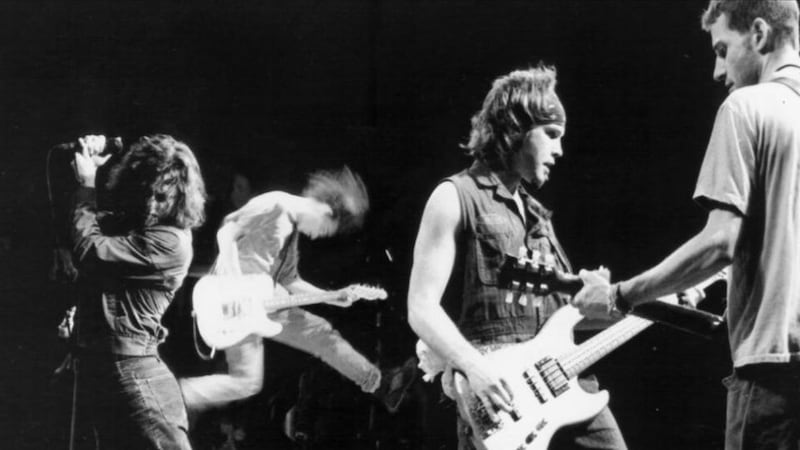Seattle will always be always be associated with grunge. It will also, of course, be associated with Starbucks, rain, Microsoft and Amazon, but it will be forever associated in musical minds with grunge, that powerful blast of alternative rock, punk and pop usually played by unshaven guys in check shirts.
Grunge was in bloom from the mid-1980s to the late 1990s and it made stars of many Seattle acts such as Nirvana, Pearl Jam, Soundgarden, Mudhoney and others. As grunge grew in popularity, acts from outside Washington State got hip to the ideas and put on their own check shirts.
But it was primarily about Seattle, as Mark Yarm's fascinating oral history Everybody Loves Our Town tells us.

Yarm's first encounter with grunge came in a college radio studio when he heard Smells Like Teen Spirit on a record label sampler.
"When I was an editor at Blender magazine, I'd written an oral history of Sub Pop on the occasion of the label's 20th anniversary, a full five years ago now," he says. "I had a lot of leftover material and a good start on a book, but probably would never have done anything with it had my agent not contacted me with the idea of expanding the article into an oral history of grunge as a whole."
What's fascinating about Everybody Loves Our Town is the amount of voices that Yarm packs into the book. Built on the back of 250 interviews, all the people you would expect to hear from are here, and more besides.
You get views from insiders and outsiders, those who benefited from the grunge boom and those who cynically looked at grunge with horror, the stars and the would-bes, the scenesters and the anti-scenesters, the punk rockers and metalheads who ended up in Seattle from the suburbs or the sticks.
That decision to bring in people who hadn’t been featured in other narratives was deliberate. “I didn’t want history to be written – or spoken, I suppose – by just the victors,” explains Yarm. “Many people know the stories behind the Big Four grunge bands – Nirvana, Pearl Jam, Soundgarden and Alice in Chains – but I wanted to also get the stories behind the less-heralded acts.
“The U-Men, for instance, were the band everyone in the Seattle scene looked up to pre-grunge. Also, I thought it was important to get the perspective of a band like Candlebox, who were super-successful yet vilified in their own hometown.”
Far from the mainstream
The various on-the-road tall tales and urban myths remind you that grunge was first and foremost about a bunch of kids having a whale of a time in a wet city far from the musical mainstream.
Everybody Loves Our Town is full of older but not really wiser folks wise-cracking about a time when they were young.
To them, grunge was a lifestyle choice, something you did because you didn’t want to be part of real life. You left school, you were in a band even if you couldn’t play an instrument, you worked a bunch of McJobs and you smoked a lot of dope.
But success came along and changed everything. Does Yarm think those involved realised at the time or only in hindsight how much everything changed post-Nirvana?
“Obviously, there was a realisation that something big was going on. I think it took quite a few years after the fact for some of the folks involved to fully process the craziness, though. Most of the people I spoke to are in their 40s or 50s and can put everything into better perspective now.
"I think a lot of my interviewees were just glad that I was including them and that the book wasn't going to be all about Kurt Cobain and Nirvana."
Yet understandably, Cobain and Nirvana dominate the grunge story, even today. “It’s not surprising, given the mythology surrounding Kurt Cobain in particular,” says Yarm. “Fans tend to romanticise musicians who lived fast and died young. Also, a lot of people perceive grunge as the last era of truly authentic music.
“What’s been interesting is seeing how a whole new generation of fans – kids who weren’t even born yet when Kurt killed himself – have embraced grunge. Finally, a lot of the bands still exist today – Pearl Jam, Alice in Chains, Soundgarden, Mudhoney, the Melvins. And then you have the surviving members of Nirvana teaming up with Paul McCartney.”
Unpredictable Courtney
One of the more colourful contributors to Everybody Loves Our Town is Cobain's widow Courtney Love, though some of her recollections don't chime with how others remember the same incident.
“I like to say that Courtney is predictably unpredictable,” says Yarm. “You’ll ask her a question and then she’ll shoot off on an unrelated tangent, only to come back to your original question eventually. Unfortunately, that may be an hour after you asked it. She certainly has her version of events, which usually doesn’t jibe with everyone else’s, but the oral history is an ideal format for presenting clashing perspectives.”
Everybody Loves Our Town will be Yarm's first and last book on this scale. "Oral histories are hard to pull off. Since it's all in other people's own words – I decided early on I didn't want to write any interstitial text – you're completely at the mercy of your subjects and whether they want to talk to you. I'm lucky I didn't have a nervous breakdown from all the worrying over who I'd get to speak with me.
“Also, there are just too many oral histories these days. Every week, a new oral history piece on this tiny music scene or that short-lived TV show pops up online. It’s just excessive.”
Mark Yarm will talk about Everybody Loves Our Town and the grunge legacy at Banter at the Set Theatre, Kilkenny on Saturday at 2pm as part of the Kilkenny Arts Festival, kilkennyarts.ie











